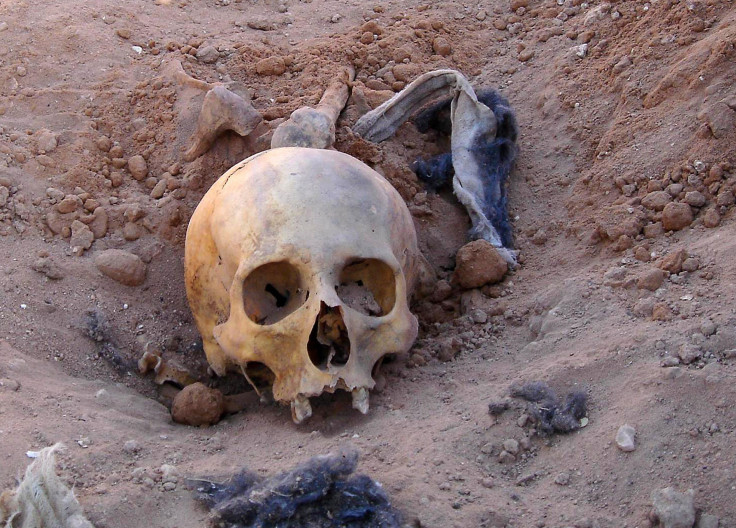Largest Known Child Mass Sacrifice Of 140 Children Linked To El Niño

The largest known child ritual killing site in the world — with corpses of more than 140 children and 200 young llamas — was discovered by archaeologists in northern coast of the Huanchaco district, Peru. Researchers believe the sacrifice might be carried out to avert a climate event like El-Niño.
The sacrifice site, formally known as Huanchaquito-Las Llamas beats the sacrificial site of at Templo Mayor in the Aztec capital of Tenochtitlán — now Mexico City — which until now, contained evidence of the largest mass child sacrifice event. Corpses of 42 children were recovered from that site, National Geographic reported.
"I, for one, never expected it," said Verano, a physical anthropologist who has worked on Las Llamas for more than three decades. "And I don't think anyone else would have, either."
More than 140 children were ritually killed in a single mass sacrifice some 550 years ago in Peru—and archaeologists think they know what prompted the act. https://t.co/R62VBT4fmc
— National Geographic (@NatGeo) April 26, 2018
The site was first discovered by Gabriel Prieto of the Universidad Nacional de Trujillo in 2011, when he was excavating a 3,500-year-old temple down the road from the sacrifice site.
Most of the corpses of children were aged between eight and 12, although there were remains of kids who were buried at 14 years of age. The sacrificed Llamas on the other hand, were less 18 months of age.
After closely examining the remains of the children, the archeologists discovered that there were evidence of cuts to the sternum as well as rib dislocations, which suggest the victims' chests might have been cut open and pulled apart in order to facilitate ancient rituals like the removal of the heart. Similar signs — consistent, efficient, transverse cuts across the sternum — were discovered on the skeletons of the Llamas.
A lack of hesitation cut marks suggest they were made by hands trained in dissecting flesh. "It is ritual killing, and it's very systematic," Verano said.
All the remains of the children were facing west, out to the sea, while Llamas were buried facing the east, toward the high peaks of the Andes. Robes and fabric discovered in the site were dated between 1400 and 1450.
The remains of three adults — a man and two women — were also found near the mass grave of the children, with evidence of blunt force trauma on their skulls. There was also a lack of grave goods in the area where they were buried. Excavators believe that the trio might have played a role in burying the children and were gotten rid of once their work was done.
According to historical experts, the mass sacrifice was part of a single event, suggested by a layer of dried mud recovered from a least disturbed portion of the 7,500-square-foot site that is believed to have covered the entire sand dune where the site is located at one point of time. It is believed that the layer was carved out during the preparation of the burial pits and the subsequent sacrifice event.
Joseph Watts, a postdoctoral researcher at the University of Oxford and the Max Planck Institute for the Science of Human History, said, while mass adult sacrifices can be explained that they were a crucial part of development of complex societies — and how elite social classes began the stratification and control of populations — “it's definitely harder to explain child sacrifice."
So why were 140 children sacrificed at Las Llamas? The archaeologists believe that sacrifice might be associated with a climate event related to El-Niño. The layer of dried mud retrieved from the site suggest that 550 years ago, there was severe rain and flooding on the generally arid coastline, which would have disrupted marine fisheries in the area, while coastal flooding could have overwhelmed the extensive infrastructure of agricultural canals of the Chimú empire – which was located in the area at the time of the sacrifice.
Haagen Klaus, a professor of anthropology at George Mason University, who was not a member of the Las Llamas project, explained that when adult human sacrifices did not bear any results, societies blinded by superstitions and mythical beliefs at the time must have resorted to child sacrifice.
“People sacrifice that which is of most and greatest value to them," he explained. "They may have seen that [adult sacrifice] was ineffective. The rains kept coming. Maybe there was a need for a new type of sacrificial victim."
“There's this idea that ritual killing is contractual, that it's performed to get something from supernatural deities. But it's actually a much more complicated attempt at negotiation with those supernatural forces and their manipulation by the living,” he added.
© Copyright IBTimes 2025. All rights reserved.





















